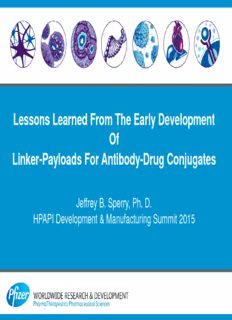
Lessons Learned From The Early Development Of Linker-Payloads For Antibody-Drug Conjugates PDF
Preview Lessons Learned From The Early Development Of Linker-Payloads For Antibody-Drug Conjugates
Lessons Learned From The Early Development Of Linker-Payloads For Antibody-Drug Conjugates Jeffrey B. Sperry, Ph. D. HPAPI Development & Manufacturing Summit 2015 Outline • Discuss how Pfizer classifies HPAPIs – Occupational Exposure Band (OEB) values • What is an ADC? • Lessons learned from the early development of linker-payloads (LPs) for ADCs – Challenges with OEB5 classification process • Who is responsible for classification? • How do we effectively communicate hazards? – Challenges with LP chemistry • Use of Synthesis Management Teams (SMTs) to facilitate development of LPs • Case studies Pfizer Confidential │ 2 Pfizer Occupational Exposure Values Occupational Exposure Limits (OELs) An 8 hour time-weighted average concentration of a substance in air to which it is believed that employees may be exposed, without personal protective equipment, for eight hours per day, 40 hours per week, without adverse effect. Occupational Exposure Bands (OEBs) Occupational Exposure Bands (OEBs) are hazard classifications that correspond to specific [order-of-magnitude] airborne concentration ranges. OEBs are intended to protect workers from the hazardous properties of the compound during handling. The OEB system separates substances into different hazard categories when the available data are sufficient to do so, but inadequate to establish an Occupational Exposure Limit (OEL). • Small molecules assigned Occupational Exposure Bands (OEBs), • Large molecules (Biologics) assigned to Biotherapeutic Occupational Exposure Bands (B-OEBs) Pfizer Confidential │ 3 OEB Criteria Matrix for Small Molecules Property OEB 1 OEB 2 OEB 3 OEB 4 (D) OEB 5 Potency (mg) > 500 50 ‒ 500 5 ‒ 50 5 ‒ 0.5 < 0.5 Significant Lowest Highest Adverse Effects Concern Concern Acute Oral > 2000 300 ‒ 2000 50 ‒ 300 5 ‒ 50 < 5 Toxicity (mg/kg) Repeat-dose Tox (NOAEL: mg/kg/day) Rat (28 Day) > 500 50 ‒ 500 5 ‒ 50 5 ‒ 0.5 < 0.5 Dog (28 Day) > 300 30 ‒ 300 3 ‒ 30 3 ‒ 0.3 < 0.3 Rat (90 Day) > 200 20 ‒ 200 2 ‒ 20 2 ‒ 0.2 < 0.2 Dog (90 Day) >100 10 ‒ 100 1 ‒ 10 1 ‒ 0.1 < 0.1 Monkey > 100 10 ‒ 100 1 ‒ 10 1 ‒ 0.1 < 0.1 Ames or Other Cat 3 (R68) Genotoxicity Negative Negative Single in vitro Cat 1 (R46) Cat 2 (R46) Geneotox Positive Cat 3 (R40) Cat 1 (R45) Carcinogenicity Negative Negative Negative Cat 2 (R45) Reproductive Cat 3 (R62/63) Cat 1 (R60/61) Negative Negative Negative Toxicity Cat 2 (R60/61) Pfizer Confidential │ 4 Pfizer Definitions Typ e Occupational Occupational Biotherapeutics Exposure Level Exposure Band Occupational (OEL) (OEB) Exposure Band (B- OEB ) based on ADI Potent <10 μg/m3 (0.01 mg/m3) OEB 4 B-OEB 4 Com pound (10-100 μg/day) Highly Potent <1 μg/m3 (0.001 mg/m3) OEB 5 B-OEB 5 (<10μg/day) Compound • Compounds handled within a research environment are “born” as unclassified from an occupational toxicology perspective unless data indicates otherwise. Unclassified compounds are handled as Occupational Exposure Band 4 (OEB 4s). • This requirement applies to all Laboratories, Vivarium and Clinical Manufacturing activities . ADI – Allowable Daily Intake Pfizer Confidential │ 5 OEB 5 Compounds • Certain criteria and or concerns drive more conservative handling: • Projected potency of < 0.5 mg (or lower end of potency range < 0.5) • Analogy to other similar highly potent compounds • Mechanism of action – known or suspected to affect rapidly dividing cells • Classification is usually compound specific but in some cases is made for classes of compounds (Vitamin D analogs, ADCs) • An OEB 5 or B-OEB 5 classification stays with the compound in all physical states (solid, solution, formulated product), it does not change unless the data set drives a re-classification • The exposure potential varies depending upon the physical state, amount being handled and effectiveness of controls available Pfizer Confidential │ 6 Compound Classification Process Pfizer employs a Global Compound Classification Process: – Conducted by EH&S – Compound classification decisions are made in partnership with Research Project Teams to ensure all relevant data is considered. – Classification is initiated in line with R&D development stage-gates. – Pharmacological (or toxicological) data points used (mechanism of action, potency projections, and structural analogy) – As compounds move through the development process and information is generated on their toxicological profile, further evaluations are undertaken for worker safety endpoints Pfizer Confidential │ 7 What is an Antibody-Drug Conjugate (ADC) Pfizer Confidential │ 8 What is an ADC? Pfizer Confidential │ 9 Highlighting Structural Complexity Palbociclib Small molecule Linker-payload < 500 MW > 1000 (ADC: 150,000) 0-3 Chiral centers 8-14 OEB 4 OEB classification OEB 5 (high potency) Synthetic steps\ Typically <15 15-25 (longest linear) Crystalline Final form Amorphous Crystallization Purification Chromatography Pfizer Confidential │ 10
Description: